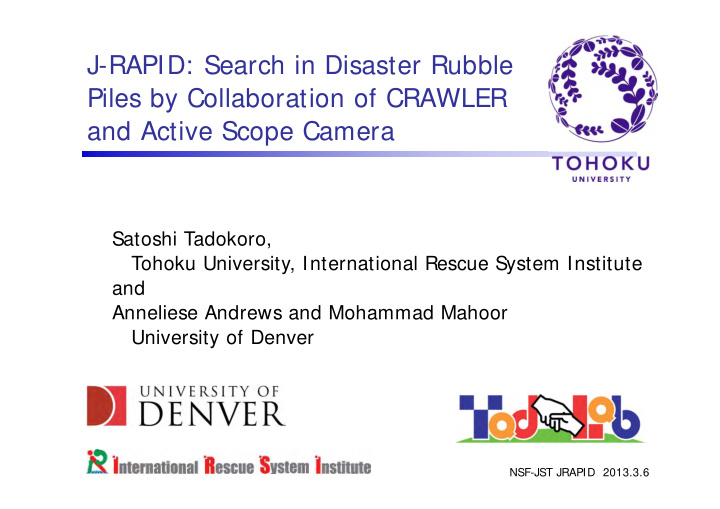



J-RAPID: Search in Disaster Rubble Piles by Collaboration of CRAWLER and Active Scope Camera Satoshi Tadokoro, Tohoku University, International Rescue System Institute and Anneliese Andrews and Mohammad Mahoor University of Denver NSF-JST JRAPID 2013.3.6
RAPID: CRAWLER Robot with Dual-Use Limbed Locomotion and Manipulation for Void Inspection Anneliese Andrews and Mohammad Mahoor University of Denver and Satoshi Tadokoro International Rescue System Institute / Tohoku University
Proposed Work - CRAWLER & Active Scope Camera • CRAWLER aka TerminatorBot – Limbed Crawler for Rubble Penetration – Two limbs for locomotion and manipulation – Drags body like a cold-blooded animal • Physical Enhancements – More robust limb design – Water proof skin – Cellphone chip camera • Active Scope Camera (ASC) – Mobile video scope with Actuated Cable Skin – Robust intrusion into narrow gap of rubble piles – Need of Explosion Proof • Application to CRAWLER – Actuated Control Tether for deep penetration
Proposed Work - CRAWLER: Results • More Robust Elbow Design – Eliminates Precision Gears (subject to dirt and damage) – Tougher Cable Drive • Cellular Phone Chip Camera – < 1 cm in Size, Digital – Easy to include multiple cameras – FPGA-based frame grabber • First Visit to Sendai Region in Nov. 2011 – Tohoku University for lab tests
Active Scope Camera for Search in Confined Space Video Scope with Search in 3 cm gap Active Surface ( Oct.3, 2006 @ Intl. Disaster (Intl. Rescue System Inst. Relief Team Exercise) Kobe Lab., Collapsed House Simulation Facility) (Tadokoro, Tohoku U)
Ciliary Vibration Drive Mechanism [Actuator2006, IROS2006] Principle of Motion Drive by reaction force produced by pressing inclined cilia using vibration Tips of cilia repetitively stick and slip direction of movement ① ③ Body ② End of Cilia
Active Scope Camera Actuation by the whole surface Change the direction of motion
J-RAPID Objectives Enhance collaboration of DU and Tohoku U More performance of ASC Long design for deep search - scalability of fabrication Higher mobility Anti-explosion of ASC Application of fluid water-hammer actuator Active tether for mobile robot CRAWLER of DU For more deep penetration Collaborative experiments
Proposal: Tube ‐ type ASC Conventional Vibration motor Head bending Cables Industrial videoscope All motors and other components are New installed inside the tube Head bending Vibration motor Cables Swing Tube Electric circuit • Advantages – No projection out side of the tube – Enough space to mount
(1) Suitable tube design • Criteria – Flexibility in order to insert into narrow space – High torsion rigidity for twisting operation – Low damping to propagate vibrations ⇒ Experiments We selected a corrugated tube ‐ Flexibility by the corrugated structure ‐ High torsion rigidity by being made from a hard material
(2) Smart head bending mechanism Designed to satisfy three points 1. Expand the length of the motion range 2. Maintain the bending angle at 90 degrees 3. Increase the occurring impelling force Adopted a wire pulling drive with McKibben actuators Composition of the head bending ‐ Four McKibben actuators McKibben actuator Wire Guides ‐ Bend in 2 degrees of freedom ‐ Controlled ON or OFF ‐ Actuator length: 240 mm Corrugated tube Bending tube ‐ Moving part length: 120 mm
(3)Auditory communication and gravity indicator • Development of electric circuit put in the tube Electric circuit – Miniaturization • Small microphone, speaker • 3 ‐ axis accelerometer • Microcontroller • Operation with gravity indicator Selects a suitable bending direction Understands map information •Image indicates the color corresponding to buttons •Image rotates for adjusting the gravity direction
ASC system for rescue operations Overall the length: 8.1 m Outside diameter: 37 mm Vibration motors: 27 motors total (300 mm Intervals) Functions • CCD camera • The head bending mechanism • A auditory communication system (A microphone and 9 speakers) • A gravity indicator • Gas ‐ drawing pipe
ASC for Vertical Insertion (1) Active Scope Camera (4) Rotational Drum Drum - Ciliary Vibration Drive - Control insertion - Motion on rubbles by rotation ASC - Reduction of friction Controller (5) Wireless (2) Turning Head Comm. - Obstacle avoidance Wireless - Remote - Wider field of view control of system (3) Camera + Light OCU - Wide field of view - LED Turning Head Bottom
New ASC System Controller Air Compressor Wired Comm. Cable Horizontal Motion Remote Control PC 2-DOF Bending Mechanism Camera + LED Bending Head
Experimental Result
Conclusions Purpose: Collaborative improvement research of rescue robots, CRAWLER and Active Scope Camera (ASC) Major Achievements: Finding effectiveness of ASC technology for CRAWLER's tether and WH actuator for ASC Physical enhancement of CRAWLER (robust limb design, water proof skin, cellular phone chip camera) New-type high-power water hammer actuators with compact design for potential use in ASC New design of tube-type ASC which can use the water hammer actuator High performance of tube-type ASC in narrow passage (motion through 25 mm-diameter pipe-elbow systems) New-type flexible pneumatic actuator designs with explosion proof High-speed motion of the flexible pneumatic actuator up to 7 m/s Application of the flexible pneumatic actuator for new-type ASC for uneven terrain Improvement of mobility of ASC on rubble piles Voice communication capability with victims under rubbles Image processing functions for measuring and showing the gravity direction Practical verification of new ASC at firefighters' training center
Recommend
More recommend